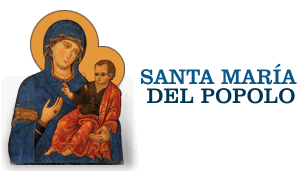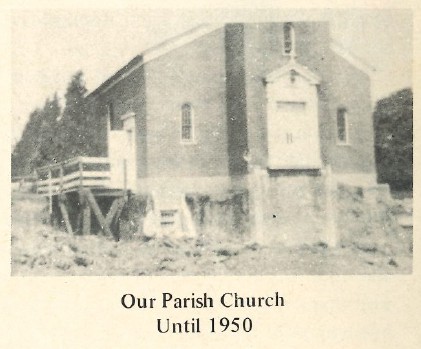
The roots of Santa Maria del Popolo Parish are intertwined with the Village of Mundelein, and with the man for whom the village is named.
Archbishop George Mundelein gave the Village of Area a great boost when he chose it for the site of St. Mary of the Lake Seminary in 1920. Grateful for the enhancement of village reputation and revenues, in 1924 the board of trustees elected to change the village’s name to Mundelein (its fourth and longest-lived name change). In appreciation of that honor, the cardinal presented the village with its first firetruck the following year.
According to the 1930 census, Mundelein’s population just topped 1,000. By 1935, the population was probably about 1,150, and there were 75 Catholic families in the village and surrounding areas.
These families belonged either to St. Mary of Fremont Center or to St. Joseph’s Parish in Libertyville, and parents paid 25 cents a week for bus service if they wanted their children to attend St. Joseph’s School. Perhaps both because of the growing number of Catholic families, and a fondness for «his» village, the cardinal deemed it time to found a separate parish there.
On April 19, 1935, Cardinal Mundelein appointed the Reverend Thomas Burke, a member of the first class of seminarians ordained from St. Mary of the Lake, pastor of the parish-to-be. The choice of the new parish’s name perhaps also resulted from the place the village held in the cardinal’s heart. Santa Maria del Popolo (St. Mary of the People) was the name of the cardinal’s titular church in Rome, the church given to his charge when he received his red hat in 1924.
According to archdiocesan annals, not only did Cardinal Mundelein contribute financially to the begin-nings of the parish, he also insisted that the church be built in the colonial style («the only distinctive American architecture, » he said). It would thus be reminiscent of the buildings at the seminary. In May, ground was broken for the new church. Cardinal Mundelein had purchased two lots from Robert P. Rouse (then mayor of the village) and George D. Mayer, and ac-quired a third from the State Bank of Mundelein. The lots, which fronted on Lake Street, were federal land until 1844, when they were purchased by the William Colvin family. The land subsequently changed hands several times, and a white farmhouse built on it in the late 1800’s was often rented out.
It was in this farmhouse, which would serve until 1983 as the parish rectory, that Father Burke first celebrated Mass on May 19, 1935. William Dorfler and Norman Ullrich served at this first Mass, for which the congregation sat on folding chairs in the parlor.
Cardinal Mundelein dedicated the church on September 22, 1935.
Among the first families of the parish were the Althaus, Beauvais, Braun, Cizek, Dishinger, Engelbrecht, Dorfler, Hogan, Kelroy, May, Murphy, 0 ‘Hem , Pfannenstill, Ullrich, Wells and Wirtz families.
Parishioners who remembered Santa Maria’s earliest days recalled «It was quite an event to get our own church.» They also recalled all the work they did to support it. Foresmost among these memories are the legendary chicken dinners that, according the long-time resident Mae Sullivan, «put the foundation under the parish!» The sisters at the Benedictine Convent of Perpetual Adoration (now Marytown) often con-tributed food as well.
The chicken dinners and the annual carnival were both major funding-raising events and major social events for those who, according to one old-timer «lived at the church eight nights a week.» There were no guilds or societies, no meetings or dues, but in the words of so many who were there, «Everybody pitched in.»
In addition to the family-style dinners on the church lawn, there were also formal dinners at downtown spots such as the Edgewater Beach Hotel and the Palmer House. There were Thanksgiving festivals, raffles and card parties in the church basement — anything to bring in some extra dollars and have a sociable evening in the bargain. Prizes for those evenings ranged from bottles from the local taverns to produce from the local farms, including, as one family vividly remembered, a live rooster.
Many high school students belonged to the Young People’s Club that was organized in 1937, but the club disbanded «when the boys went into service.»
In those days, the sisters from the Benedictine convent gave instructions for the sacraments, and many youngsters were bundled into Father McTigue’s car to attend classes after school. «It was a two-door with a small back seat,» recalled Mary Ann Starkey, «but we all squeezed in.»
Diamond Lake was still quite a popular resort then, and home to the «summer parishioners» who rented cottages and cabins there.
Early parish memories also include huge wash boilers used for making coffee-for-hundreds («we got the best compliments!»); skinned knees («we scrubbed that chapel top to bottom twice a year: walls, win-dows, venetian blinds . .») and the stove (still working) that Raphael Gagnon’s aunt, Sister Mary Raphael Costello, donated when her convent was closed. Mrs. Gagnon’s father, Michael J. O’Kelly, brought the stove to Santa Maria from Chicago just a year or two after the church was built.
Genevieve La Magdeleine was the first organist for the parish; Marian Beauvais was the first choir direc-tor; and Adeline Krueger and Raphael Gagnon were the first «in-house» catechists; they taught from the late ’40’s until 1950.
The «boys» fortunate enough to return from World War II often used their GI benefits to finish their education and start their families. There was a housing boom in Mundelein after the war, and by 1950 the population was 3,000. It was time Santa Maria had its own school.
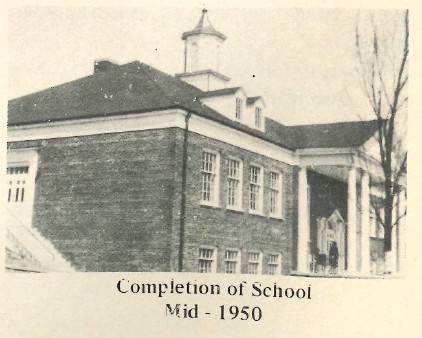 Father McTigue instituted a Century Club for those who gave $100 to the building fund (and that was when, as a former parishioner said, «One hundred dollars was worth $100!»). A four-room school, built onto the church, was opened on September 5, 1950.
Father McTigue instituted a Century Club for those who gave $100 to the building fund (and that was when, as a former parishioner said, «One hundred dollars was worth $100!»). A four-room school, built onto the church, was opened on September 5, 1950.
One hundred eighty-seven children were enrolled that year, and four Sisters of St. Dominic from Adrian, Michigan, were their teachers. According to Mrs. Gagnon, her father had a hand in the sisters’ arrival, too. Father McTigue com-mented to Mike O’Kelly that it was difficult to find sisters willing to come to this faraway place to teach, and Mr. O’Kelly said, «Let me ask my friend.» His friend from child-hood was Mother Mary Gerald Barry, superior of the order in Adrian. Thus it was arranged that the Dominican Sisters would teach here, and here they have taught ever since.
The annals kept by the sisters noted that for the first M id 1950 week, classes were in the basement, pending the arrival of desks. (Another early school memory is of being able to pur-chase a desk, for S75, in memory of a loved one). Later on in September of 1950, the schoolchildren’s mothers gave a pantry shower for the pioneering sisters.
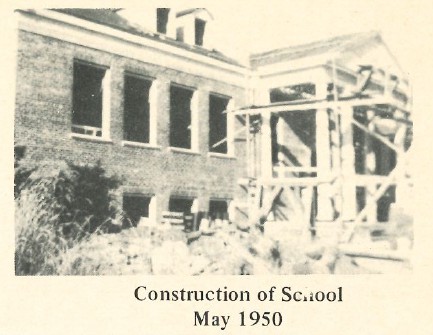 Santa Maria pupils wore uniforms for the first time on January 4, 1951. The girls wore navy skirts and white blouses, and the boys wore dark trousers, tan shirts and royal blue ties. Beginning another long-standing tradition, the children had bicycle and doll raffles to raise money for the school.
Santa Maria pupils wore uniforms for the first time on January 4, 1951. The girls wore navy skirts and white blouses, and the boys wore dark trousers, tan shirts and royal blue ties. Beginning another long-standing tradition, the children had bicycle and doll raffles to raise money for the school.
Thirty-nine children received their First Communion on Mother’s Day in 1951. In June, nine students graduated in the Class of ’51. By that time, work had already begun on two new classrooms.
During this time, the five sisters now teaching at Santa Maria School lived in the farmhouse — rectory, and Father McTigue lived above the school. Construction of the convent at 133 N. Lincoln was begun in May, 1952, and the sisters moved in just before school started in September of 1953. And in the spring of ’53, the proceeds of the children’s bicycle raffle went toward purchase of a stained glass window for the con-vent chapel.
During this time, the five sisters now teaching at Santa Maria School lived in the farmhouse — rectory, and Father McTigue lived above the school. Construction of the convent at 133 N. Lincoln was begun in May, 1952, and the sisters moved in just before school started in September of 1953. And in the spring of ’53, the proceeds of the children’s bicycle raffle went toward purchase of a stained glass window for the con-vent chapel.
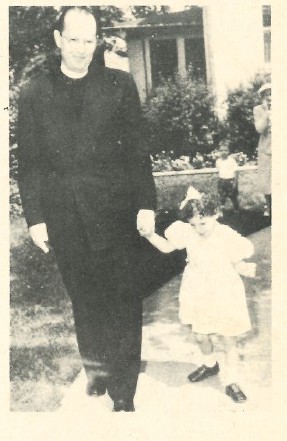 Meanwhile, in the summer of 1952, the Very Reverend Monsignor Peter Meegan was appointed pastor, and in the recollections of those who were here, little at Santa Maria was ever the same. When Monsignor Meegan ar-rived, there were 300 families in the parish, and church and school were be-coming crowded. In 1956, the school grew by nine classrooms, and its base-ment provided a chapel that could seat 650 people.
Meanwhile, in the summer of 1952, the Very Reverend Monsignor Peter Meegan was appointed pastor, and in the recollections of those who were here, little at Santa Maria was ever the same. When Monsignor Meegan ar-rived, there were 300 families in the parish, and church and school were be-coming crowded. In 1956, the school grew by nine classrooms, and its base-ment provided a chapel that could seat 650 people.
More memories: the men who hammered away in Ben and Genevieve LaMagdeleine’s garage to build the pews for the basement chapel. Many were the same ones who helped pour the concrete and inlay the cross in front of the school. The new place of worship was soon outgrown by its congregation, some of whom recalled that the doors would be locked right before Mass, so that no one else would try to squeeze into the already crowded pews.
Other memories include the Christmas crib that was set up outside the church, with an old jukebox playing Christmas Carols; the wink that would get a shot of whiskey in one’s soda at an officially «dry» fund-raising party; and the pumpkin sculpture of Monsignor Meegan that made the rounds of the parish long after one particular Halloween.
During Monsignor Meegan’s time as pastor, parish activities were legion, each bearing the stamp of his influence. The scouting program for boys and girls began then, as did the St. Vincent de Paul Society.
The Altar and Rosary Society, the Holy Name Society, the Knights of Columbus, the Mount St. Joseph Guild and La Puerta Abierta (The Open Door) all began while Monsignor Meegan was at Santa Maria. The Altar and Rosary Society, in addition to caring for the church, maintained a phone chain, and members would come to pray with bereaved families at wake services. Through the Mount St. Joseph Guild, members «adopted» residents of Mount St. Joseph, a home for retarded girls and women.
One of the memories of this guild is of a quilting bee at the Hinderyckx home. Some servicemen who were spending their leave at Diamond Lake, where Les and Dorothy rented cabins, wandered by and asked if they could help. With the Army, the Navy and the Marines pitching in, the quilt was finished in a day and a night.
La Puerta Abierta was begun with Campaign for Human Development funds to provide translation ser-vices, aid in finding employment, and general support for Spanish-speaking members of the community, as well as a low-cost clinic for anyone who needed it.
In 1953, the sisters from the school began teaching catechism to public school students for an hour after the 9 o’clock Mass («the children’s Mass») on Sunday mornings. The Altar and Rosary Society gave the sisters’ annual shower, adding a freezer to the convent appliances in 1953, and an automatic washer the following year.
Santa Maria’s prayer group began while Monsignor Meegan was pastor, starting with a handful of people whom he asked to pray for a special intention. Over the years it would wax and wane, but the prayer group would come to be seen as a strong positive spiritual and social force in the parish.
In the spring of 1957, 116 children received their First Communion — so many, that two First Comm-union Masses were celebrated to accommodate all the children and their families. The school year of 1959-60 was marked by the enrollment’s going over 1,000, and by a visit from Illinois poet and historian Carl Sandburg. The sisters noted in their annals that the eighth-grade class recited «Fog» for Mr. Sandburg, and that the author was «greatly impressed.»
In 1962, a new church-school, with 10 classrooms, was built on the northeast corner of Lake and Court-land streets, where an apple orchard had stood. The new classrooms (described in the sisters’ annals as «the school annex») opened on October 31, 1962. When Albert Cardinal Meyer dedicated the new building on May 3, 1964, 1,900 families belonged in the parish. Fourteen sisters and 12 lay teachers had charge of 1,230 pupils. An additional 320 youngsters received catechism instruction.
In 1968, the first school board at Santa Maria was elected. An Adult Awareness Program (predecessor of the Adult Religious Education Committee), began then, as did the SPRED (Special Religious Education) program.
Yet another beginning in the late ’60s was the celebration of Mass in Spanish. It began when the Car-melites were asked to celebrate Mass for the Latin workers at Fiore’s Nursery. The Mass was moved to Santa Maria chapel, and soon drew people from all around this part of the county.
According to Father Pierce Gilmartin, this «transitional church,» along with La Puerta Abierta, gives comfort, as well as a little help and a little nudge to get people into the mainstream of society. «I have seen lost souls become very comfortable, after being in a very, very difficult time. I have seen a lot of progress,» said Father Gilmartin.
At Santa Maria, it seemed that the growth would never end. The parish acquired still more property to provide ample playgound and parking space for its burgeoning family. Even the big church was looked upon as temporary, having been designed with an eye toward ease of converting it to a gymnasium when another church would be built, further north on the west side of Lake Street. As it turned out, that land was sold to Frank Kline, who built and opened the Lake Manor Apartments for senior citizens in 1977.
In the early ’60s, a scruffy young songwriter was singing about how the times they were a-changin’. On the other side of the world, a gentle, rotund Pope was saying the same thing, using the word «aggior-namento» (updating). With English instead of Latin, turned-around altars, guitars in the church, lectors, commentators and extraordinary ministers of the Eucharist, to some it seemed that the fabric of worship was being shredded. Even among those who welcomed the changes, (for the ones who remembered tux-edoed ushers at Christmas Midnight Mass), it wasn’t always easy.
As happened in many parishes, those who were displeased showed it by withdrawing from church and school, and in some cases frcm the parish entirely. From an all-time peak of 1,278 in the 1965-66 school year, student enrollment began to drop. According to archdiocesan annals, church attendance and financial support decreased to the point that in 1972, the school’s future was in doubt.
But again, there was a turning around. A parish increase-in-offertory campaign, together with weekly Bingo and annual Las Vegas Nights instituted by the school board, helped keep the doors open.
Change came to Santa Maria in many different forms. One change with which the parish led the nation was the admission of women to the St. Vincent de Paul Society in 1970. In the words of John Simmons, national president of the society, «Our wives were doing the work anyway, but weren’t officially recog-nized.»The national organization moved to admit women in 1979. Another change came in 1972, when Thomas Kasbohm, the parish’s first permanent deacon, was ordained.
That same year, Debra Titus started playing the organ at three Masses. She went on to become the par-ish’s first full-time organist and music director, organizing the current 10:30 choir in 1977 and the 9:00 choir in 1978. In addition, Mrs. Titus has organized children’s choirs to sing for special occasions. Like music itself, the choirs have had their ups and downs, but their numbers have increased during the last few years.
During the ’70s, the tensions and conflicts within the parish did not ease. As a step toward healing, a steering committee was formed in 1976 with the goal of establishing a parish council the following year. The council, with its commissions to care for spiritual development, social ministry, education, parish life and services, and liturgy, continues to come into its own.
In the late ’70s, Santa Maria’s youth group was formed, with the aim of providing a balance of spiritual and social growth for the young people of the parish. In the words of its members, the group offers a place to get away and be oneself, a sense of accomplishment, and a sign that teens are an important part of the community. Father Jim Mcllhone is the youth chaplain, and John Werning is the youth minister. Mr. Werning is also the religious education coordinator, overseeing the Confraternity of Christian Doctrine classes and the SPRED and Family Faith Development programs. The four-year-old FFD group brings families together to learn and celebrate their faith.
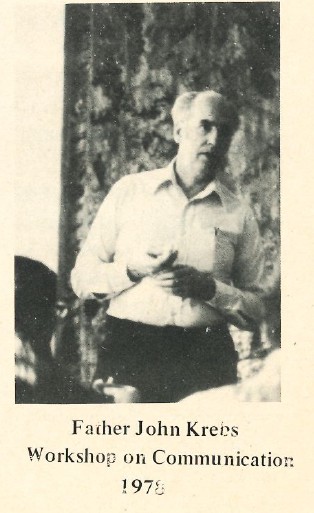
For couples interested in Marriage Encounter, Alice and Jerry Donohue have served as leaders and as a contact couple in this program for the past 15 years.
Sister Grace Henneberry, who arrived at Santa Maria in 1966, and has been principal of the school since 1969, has a strong sense of family in the parish. Among her memories are the alumni returning to help tear down walls between two classrooms to build the library in the west school; and parishioners helping to paint classrooms and halls, and to install ceiling tile, floor tile and carpeting. Included here too are the visits of former students who return, often with spouses and children, to say, «This is where I went to school.»
Changes that the school has seen include the learning centers that were es-tablished in 1970. In 1977, Santa Maria opened an all-day kindergarten, whose success may be measured by three kindergarten classes, and by parents’ willingness to rise before dawn to register their children. In 1983, Santa Maria School added a computer center with 17 TRS-80 terminals, an archdiocesan first. Continuing their fund-raising tradition, the school-children netted $12,000 with a track-a-thon to pay for the computer cen-ter. Also in 1983, the school board instituted an adopt-a-student program to help financially troubled families.
And for all its growth and urbanization, Mundelein still has much of a rural heart — homebaked goods and gifts of all sorts are still brought «for the sisters,» who number four these days, but who have a special place in the hearts of those they serve.
In 1978, there were 1,816 families in the parish, and 452 students enrolled in the school. That year, parts of Santa Maria and St. Joseph’s parishes were combined to form St. Mary of Vernon Parish, and about 200 families from Santa Maria were drawn into the new parish. Currently there are 1,674 families registered at Santa Maria, and 607 children attending the school. There are 236 child-ren in the CCD program, eight young adults in the SPRED program, and 95 adults and children in the FFD program.
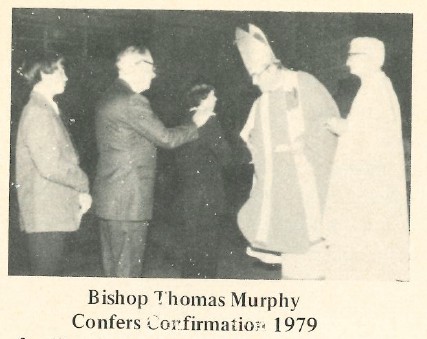 In 1979, Bishop Thomas Murphy, a former assistant at Santa Maria who today is bishop of Great Falls, Montana, returned to the parish to confer the sacrament of Confirm-ation on many of the young people he had baptized a dozen years earlier.
In 1979, Bishop Thomas Murphy, a former assistant at Santa Maria who today is bishop of Great Falls, Montana, returned to the parish to confer the sacrament of Confirm-ation on many of the young people he had baptized a dozen years earlier.
The zeal that marked the chicken-dinner days of the parish was rekindled in 1981 when an ad hoc committee took on the task of expanding and refurbishing the tiny kitchen where so many parishioners put in so many crowded hours for the church.
Helen Rumpf recalled that the last thing that Father John Lane needed to worry about was another debt, «but he trusted us.» That trust paid off, and the kitchen was paid off within a year. In that year, the kit-chen committee baked and sold millions of cookies to raise money. A dance, chili suppers, and a special spaghetti supper orchestrated by Father Bob Aguirre all brought funds to the kitchen coffers, as did pro-ceeds from a Girl Scouts’ rummage sale and a Boy Scouts’ paper drive.
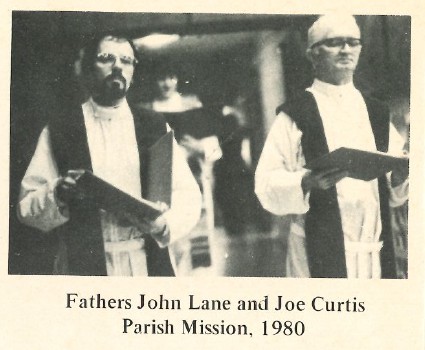 One of the earliest uses of the beautifully appointed kitchen was for the preparation of funeral luncheons, part of the work of the Compassion Ministry that was instituted by Deacon Les Rumpf, who was ordained in 1980.
One of the earliest uses of the beautifully appointed kitchen was for the preparation of funeral luncheons, part of the work of the Compassion Ministry that was instituted by Deacon Les Rumpf, who was ordained in 1980.
The parish mourned the death of two of its shepherds in 1982, Father Lane in August (he did see the kitchen completed, and it was later named in his honor), and Monsignor Meegan in December.
But there was joy, too, as Santa Maria’s third deacon, Jim Prendergast, was ordained in April of that year. And the parish opened arms and heart to welcome its new pastor, Father James Kinn, on September 16, 1982.
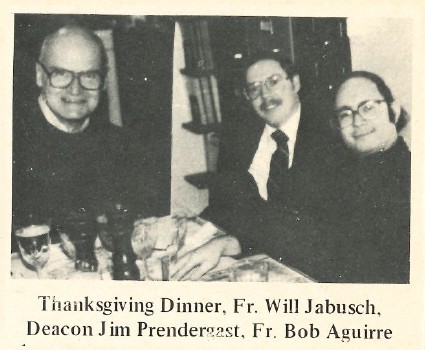 Yet another chapter was begun in 1983, when the century-old farmhouse was torn down on July 6, and ground was broken the following week for a new rectory. This new building would be not only a home for the parish priests, but for the parishioners as well, with meeting rooms, offices, a re-ligious education center, and space to store all the previously far-flung records and equipment.
Yet another chapter was begun in 1983, when the century-old farmhouse was torn down on July 6, and ground was broken the following week for a new rectory. This new building would be not only a home for the parish priests, but for the parishioners as well, with meeting rooms, offices, a re-ligious education center, and space to store all the previously far-flung records and equipment.
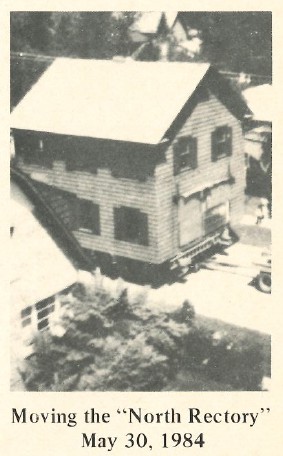 Al Dietz, Sr., who was the custodian, engineer and all-around steward of the parish for 30 years, said it was the biggest single improvement he had seen, and many echoed his words.
Al Dietz, Sr., who was the custodian, engineer and all-around steward of the parish for 30 years, said it was the biggest single improvement he had seen, and many echoed his words.
Catherine Marie, who for 19 years was the cook and house-a keeper at the rectory, and who recalled ironing in the base- 0 u ment of the old house with her gloves and boots on, was a bit sad when the building was razed. With all its discom-forts and inconveniences, the old farmhouse had been home, too.
When the new building was completed, the parishioners turned out in force to help Father Kinn, Father Aguirre and Father Mc-Ilhone move into their new home, lending not only muscle power and or-ganization, but also boxes, trucks, vans and furniture dollies. An open house and blessing of the new rectory/parish center were given on May 20, 1984. «It feels so much more like home,» said Father Kinn.
Ten days later, school children and townsfolk alike watched as the «north rectory» was lifted up and moved, to await refurbishing. Father Mcllhone and Father Aguirre had lived in the old brown house, which Monsignor Meegan purchased from the Rouse family.
In the meantime, steps were taken to make the big church itself more homelike, too, and more conducive to the parish family’s praying together.
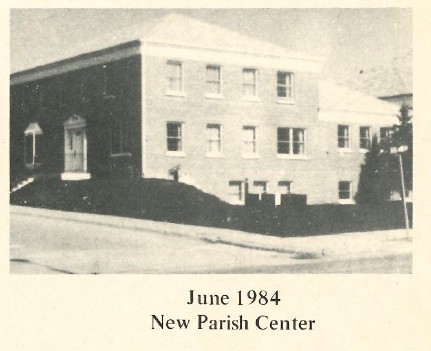 While these are the most notable physical changes that have taken place in the parish, something new and intangible is in the works as well. This is Renew, which began in September, 1984. It is a three-year program com-bining prayer, Scripture and personal experience, and many of those who have lived in the parish the longest said it is the best thing to happen to Santa Maria.
While these are the most notable physical changes that have taken place in the parish, something new and intangible is in the works as well. This is Renew, which began in September, 1984. It is a three-year program com-bining prayer, Scripture and personal experience, and many of those who have lived in the parish the longest said it is the best thing to happen to Santa Maria.
In a way, it is a return to beginnings — not only the Bible, but to the start of the parish and the Church itself — small groups of people, gathering to pray. Dorothy Hinderyckx, speaking of how everyone worked together when the parish began, could have been referring to Renew when she said, «It’s our parish . . . you grow with it. You get involved.»
— Connie Purcell
